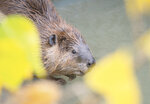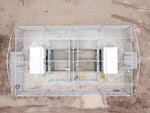The keystone species
New Cody Region beaver holding facility will help in building much needed wetlands
When Mary Rumsey finally lifted the door on the metal transport, releasing the three beaver family members huddled inside, the Meeteetse resident’s eyes lit up with joy on what was otherwise a fairly miserable day.
A cold rain moved in just in time for a small ceremony unveiling the Wyoming Game and Fish Department’s brand new holding facility at the Cody Region office for the area’s largest rodents. Of course, the fat raindrops were the least of the beavers’ worries.
The largest beaver of the three let the small crowd gathered at 2 p.m. know what he thought about the attention: The normally nocturnal species slapped his tale in the water several times, ensuring not one dry shoe to those close.
The holding facility was designed by Game and Fish Cody Region Terrestrial Habitat Biologist Jerry Altermatt. Beginning five years ago, he built a series of special trailers for the same task, but the new facility can safely house up to 32 beavers in four separate families.
The inaugural trio brought to the facility this month soon took refuge in their temporary den lined with straw. Combined with a shade screen over the entire facility, the four dens were designed to keep the heat-sensitive animals cool on hot days.
Leafy cottonwood branches, colored by fall, were added to the beavers’ cell, giving the industrious critters everything they need while they await translocation. A big lid, like an oversized cooler, will allow access when it’s time to move them to a permanent home.
Rumsey made the project possible through a huge donation, allowing Altermatt and newly hired Habitat and Access Specialist Hunter Bredeson to capture beavers faster, temporarily hold them safer and eventually translocate more of them than ever before. The team will be able to “quadruple” its efforts to create improved habitats across the Big Horn Basin.
After beavers were trapped out of most of Wyoming, erosion began incising the waterways that were once their habitats, which in turn changed vegetation and made access to life-sustaining water difficult for wildlife. Beaver dams and lodges create pools that clean sediment from the rushing water and allow the water to sustain multiple species of wildlife and vegetation — including moose.
Rumsey’s passion for moose on the Wyoming landscape is the reason she was happy to write a big check for the project.
“I love our moose,” she said prior to the unveiling.
Altermatt previously translocated a beaver family to Rumsey’s property and the resulting pools immediately helped moose in the area. The best way to cool down moose, which are extremely heat sensitive, are damp areas where they can lounge.
“I’ve seen a moose lay down on our property for 18 hours right by the river on the damp ground. That’s what beavers create,” she said. “Our moose are at risk and we simply want to do as much as we can.”
For the Game and Fish, translocating beavers is a “win/win,” Altermatt said. The state has previously built manmade dams, called beaver dam analogs, or BDAs. But they’re expensive and getting a project off the ground requires a long, time-consuming bureaucratic process. However, there’s a simple permit process to trap and translocate beavers to places that need the industrious builders.
Still, the process is difficult. Live-trapping an entire family of beavers can take as long as two weeks, Altermatt said.
If the department translocates beavers as they catch them, they will leave the new area in search of their mates and family while the trapping process is ongoing. So the department needed a temporary, safe holding facility until all the beavers can be caught and translocated at the same time, preserving the family units. The species is socially monogamous, generally living in discrete colonies composed of a mated pair and their offspring.
Thanks to Altermatt’s design — which includes removable doors separating the four individual pods — the biologist can actually be a matchmaker, introducing single beavers from different families to become possible mates.
There have been matchmaking experiments in other states, but the facility in Cody is the first in the state that can help beavers find a mate. It won’t always work, but Altermatt can step in if they can’t get along.
“There’s really not a whole lot of difference in behavior between males and females. Females can be just as aggressive as a male,” he said. “They both mark their territory, and they’ll both defend their territory.”
Successful matchmaking will help increase populations as well as genetic diversity. The more beavers on the landscape, the better backcountry habitats will be.
Since beginning the program in 2018, more than 100 beavers have been translocated in the Cody Region, which comprises the Big Horn Basin. The animals can cause problems in some areas, but problem beavers can be captured before a landowner resorts to a lethal option. The critters are then relocated to places that need the species, which work year-round without an expensive contract or maintenance fees
The process saves the state a ton of money by avoiding the need to build BDAs.
“The cost savings is huge,” Altermatt said. “It’s 1/20th of the bureaucracy of man-made beaver dams and, if you consider all the cost of trapping and moving beaver, I’d say it’s less than 1/10 of the cost of doing a BDA.”
The cost of constructing a single analog can top $100,000. The entire cost of building the new holding structure was about $60,000, with an additional $10,000 to have an engineer review the plans. (The engineering costs were covered by the WYldlife Fund, a nonprofit partner of the department, with matching funds by Wyoming Untrapped.) Over the life of the new holding facility, more than 1,000 beavers are expected to pass through, all building dams and creating wetlands 24 hours a day — as well as their future generations, he said.
“Beavers are one of the most cost effective builders of habitat,” Rumsey said. “And these beavers are being taken from where they’re causing problems, and being put in areas where they’ve been historically and where they’re really needed.”
Scientists are quickly learning how critical beavers are on the western landscape. Beavers are not only considered to be indispensable to many habitats — they’ve been called “the keystone species” of the West.
“What other species has that much impact on the habitat?” asked Cody Pitz, restoration program coordinator for the Wyoming Wetlands Society, which built the only other beaver holding facility in the state in June.
“Eighty percent of wildlife species in Wyoming are dependent on riparian habitat, yet only 2% of the West is wetland or riparian habitat. So it’s incredibly important,” Pitz said.
The organization hired two local trappers to capture beavers. Thanks to the hired hands and the new facility, they translocated 74 beavers this year.
One of the advantages to translocations, Pitz said, is the ability to place beavers where they’re needed without waiting years for families to form and eventually move upstream to make the largest impact.
One of the main issues is there are exponentially fewer beavers on the landscape. Beavers used to live in almost every stream in North America and numbered as many as 400 million. But demand for their fur skyrocketed between American colonization and the early 20th century. The industry was one of the main drivers for exploration of the West and the species was nearly trapped to extinction.
Now, beaver pelts are much less popular, causing prices to crash and ultimately easing the pressure from trappers, Pitz said.
“It’s like ten bucks for a nice beaver pelt and takes a lot of work to get that pelt,” he said.
The relationship between trappers and a conservation organization hoping to repopulate the landscape with beavers seems somewhat of an odd mix, but Pitz said they couldn’t make as large of an impact without trappers carrying on their western heritage in the region.
Predators are another threat to beaver populations. Bears, wolves and mountain lions all hunt the species and, due to the low population currently, they can have an “outsized impact” on the species.
“The density of beaver used to be so high that lions, wolves and bears didn’t have as much of an impact,” Pitz said. “Now predators, or trappers for that matter, can clear out an entire colony and there won’t be others to move into the area.”
With the two new holding facilities in the state, populations will soon be increasing. Both the state and the Society get their beavers from places where the species aren’t welcome and might have been killed had the groups not stepped in. While neither is in the business to remove unwanted beavers, when it fits their needs, it’s a great option.
To meet the need, every Game and Fish region is getting geared up to translocate beavers, Altermatt said.
“Almost all the regions now have one of the trailers just like this one,” he said, pointing to the first trailer he built for the task. “And our hope is that more of these will get built around the state.”
Because most translocations are being made to private property and isolated areas, the beaver families likely have a safe place to settle, he said. However, the department has the ability, through regulations, to close specific drainages to trapping if needed.
“We have done this over the years throughout the state — but not in the Cody Region — where beaver numbers were low and/or translocation efforts were undertaken,” Altermatt said. “Where we feel the need to protect translocated beavers, we would, in most cases, try voluntary restrictions on trapping.”
Voluntary efforts would include educating the trapping community with press releases, signs and other educational materials explaining the department is trying to establish viable beaver populations and requesting they trap elsewhere until those populations are established.
Rumsey also hopes for the construction of more temporary holding facilities.
“It’s been kind of a struggle, but hopefully facilities like this take off in other areas in the state,” she said.
If given a chance, beavers will create much needed wetlands in Wyoming, with benefits to the state’s wildlife, including native fish and ungulate populations; they also provide a natural break to help stop forest fires, she said.
“Beavers are great warriors in the fight against climate change,” Rumsey said, calling them a cost-effective option.
She credits Altermatt for his efforts to improve habitat while keeping costs low through his own industrious, frugal nature.
“Jerry is brilliant and he’s put in so much time and effort to get this done,” she said.
Altermatt, always running from the limelight as fast as possible, isn’t looking for kudos. To him, it all about improving habitat on the landscape he loves.
“Beavers are one of the best tools in our toolbox to build good riparian habitat,” he said, and seeing the first beavers in the new facility brought a smile.
“It was deeply satisfying,” he said.







